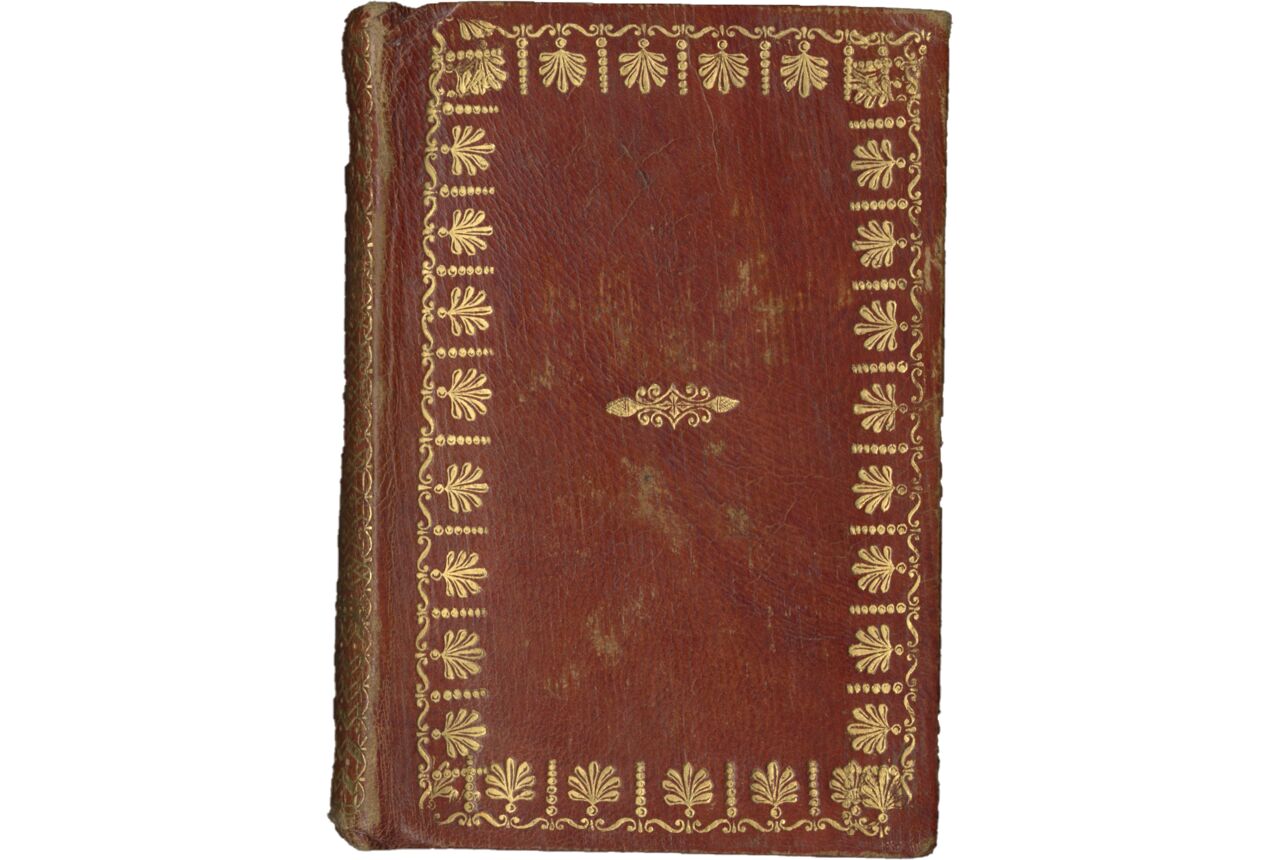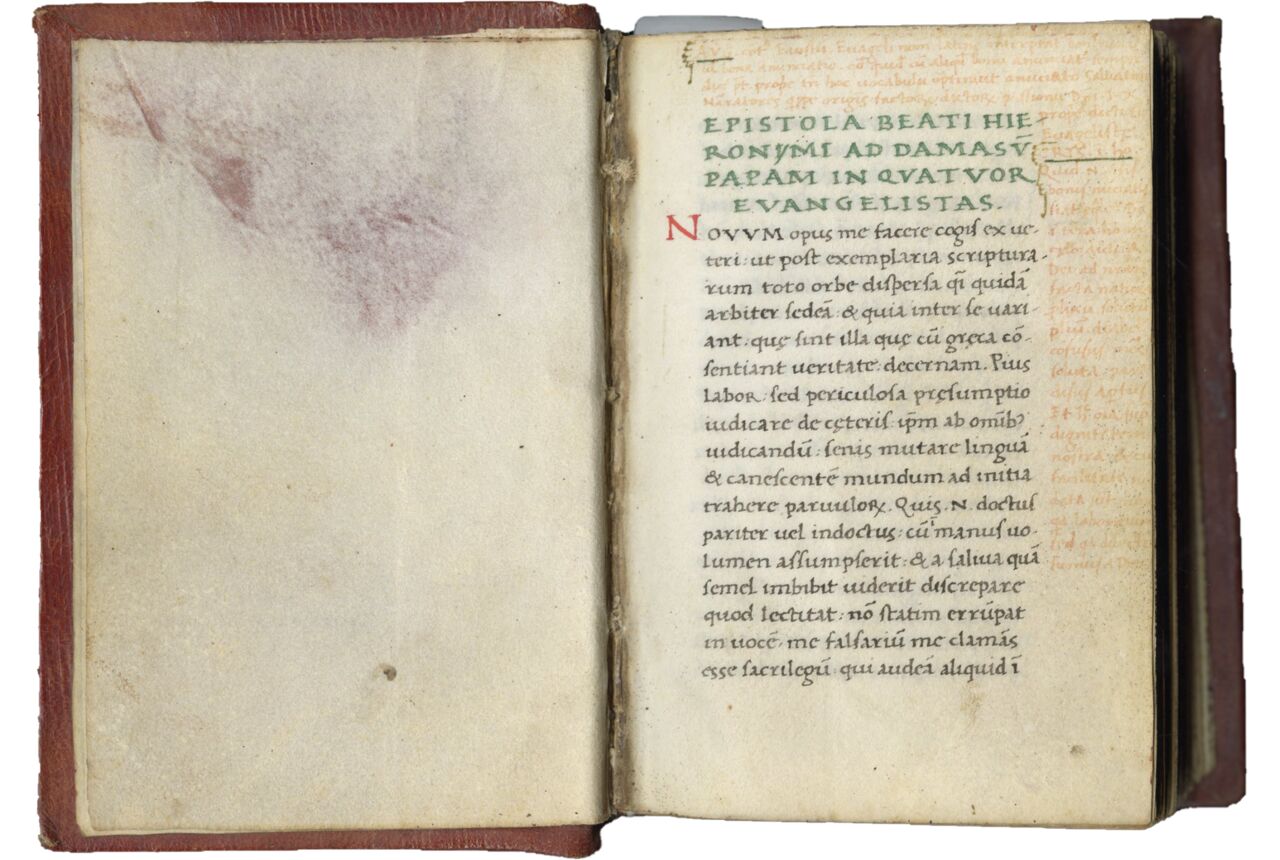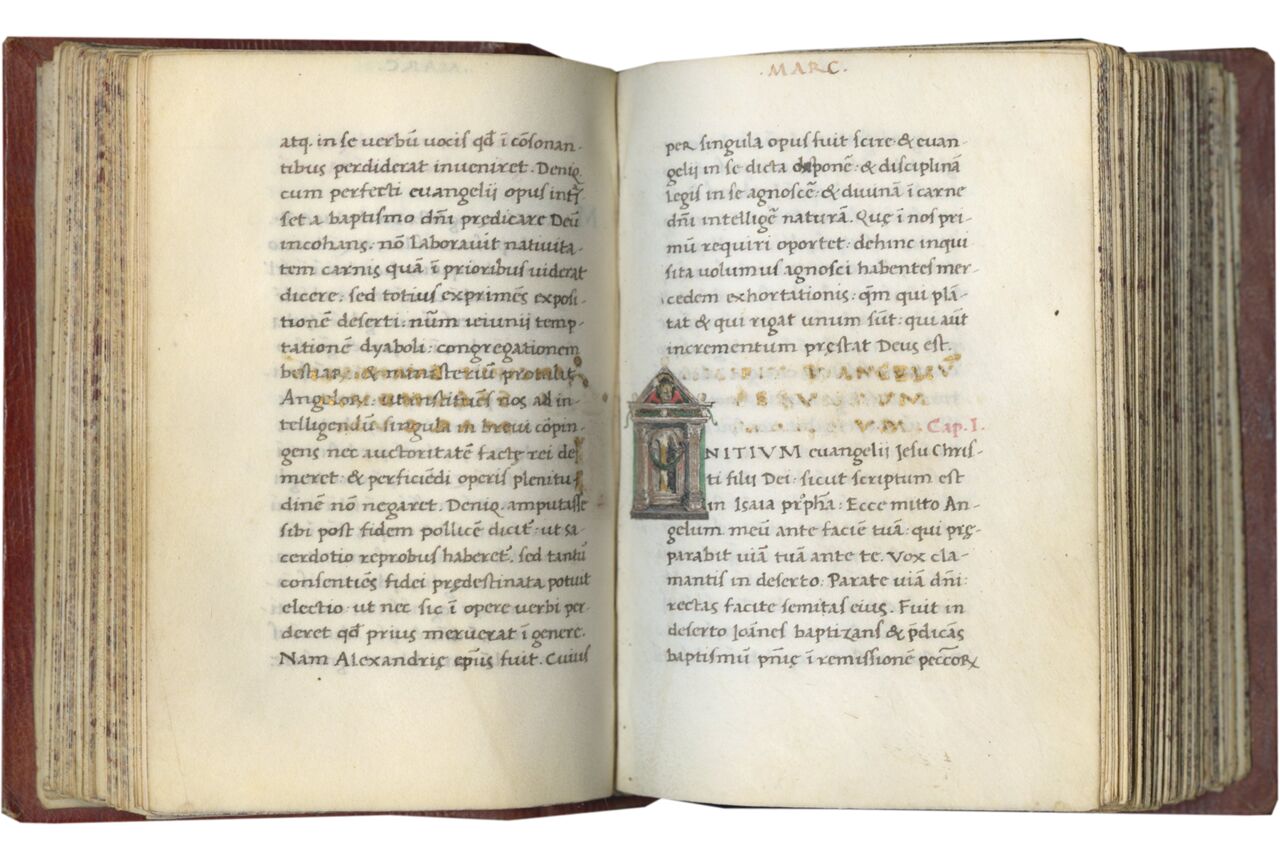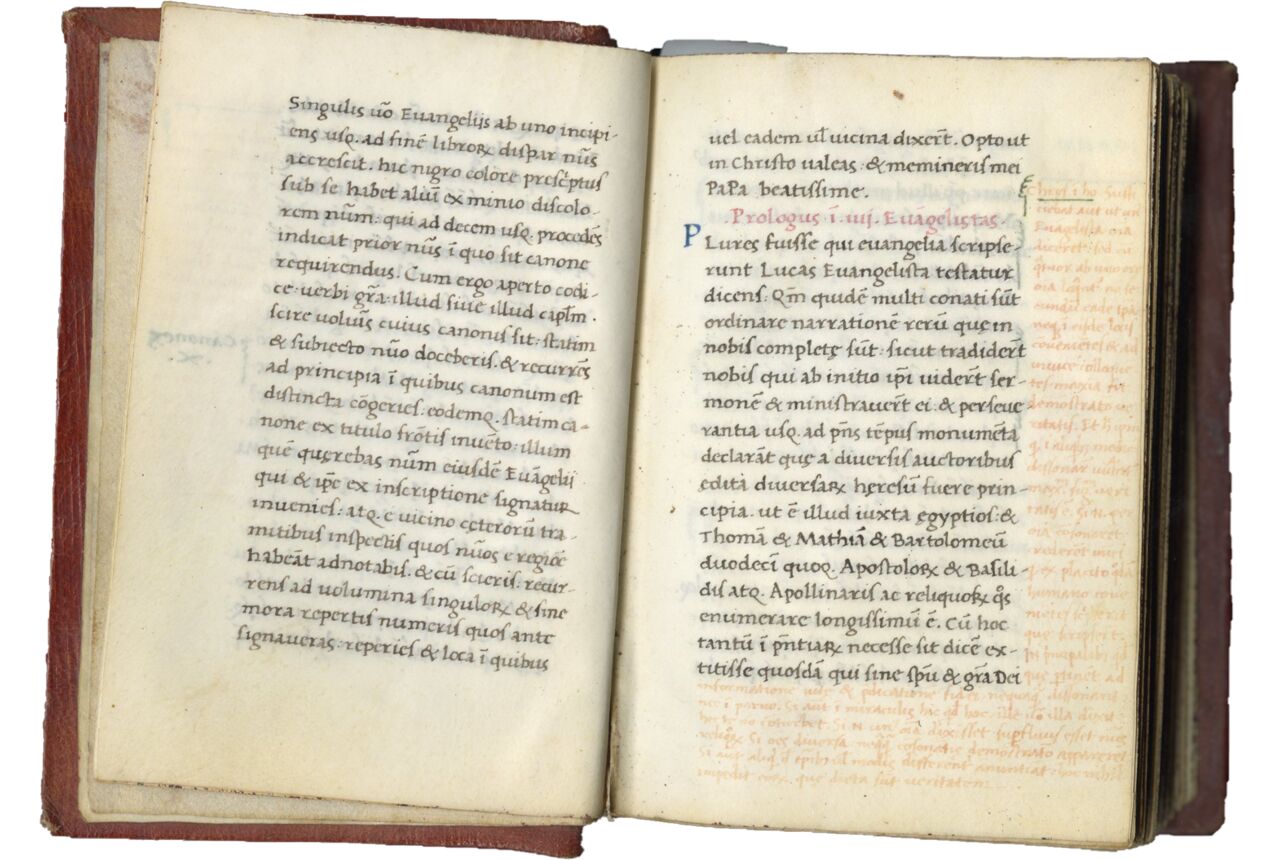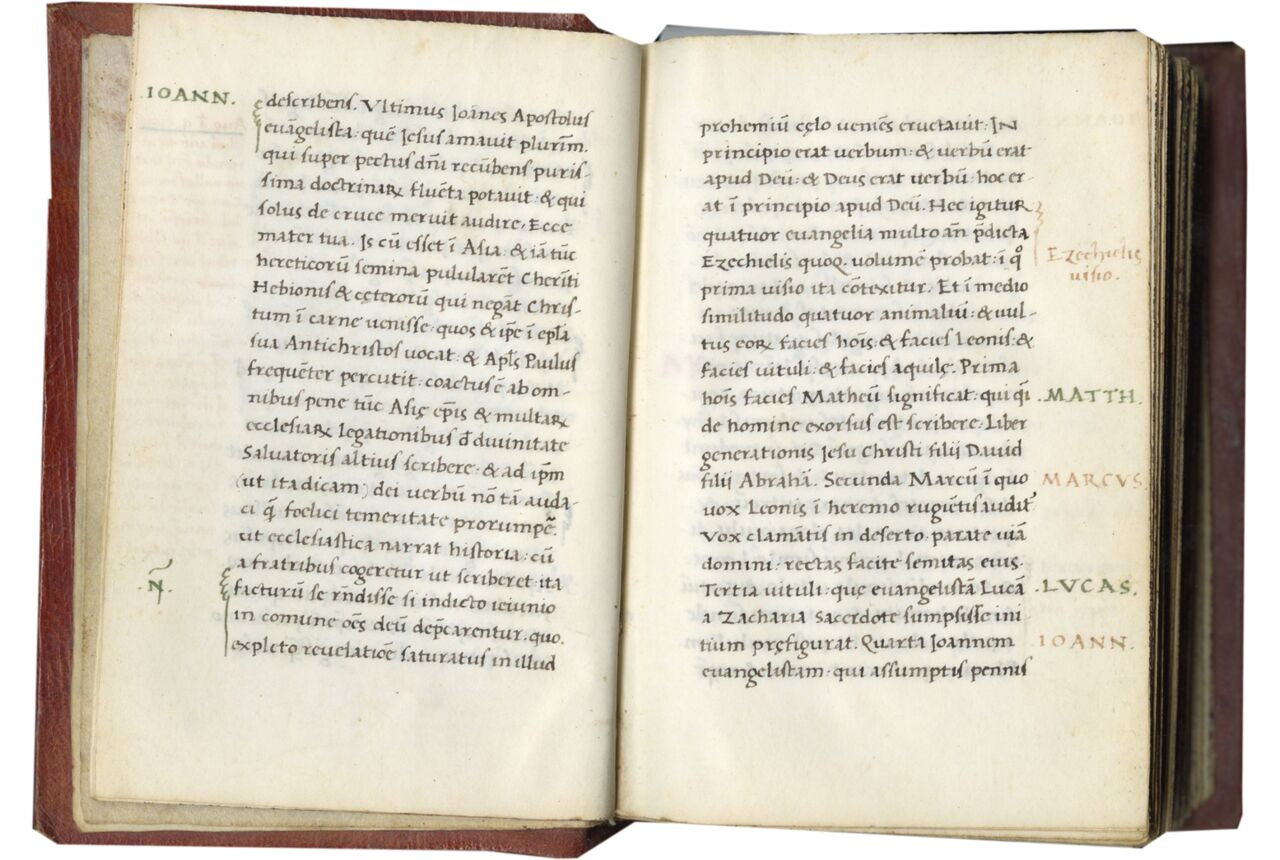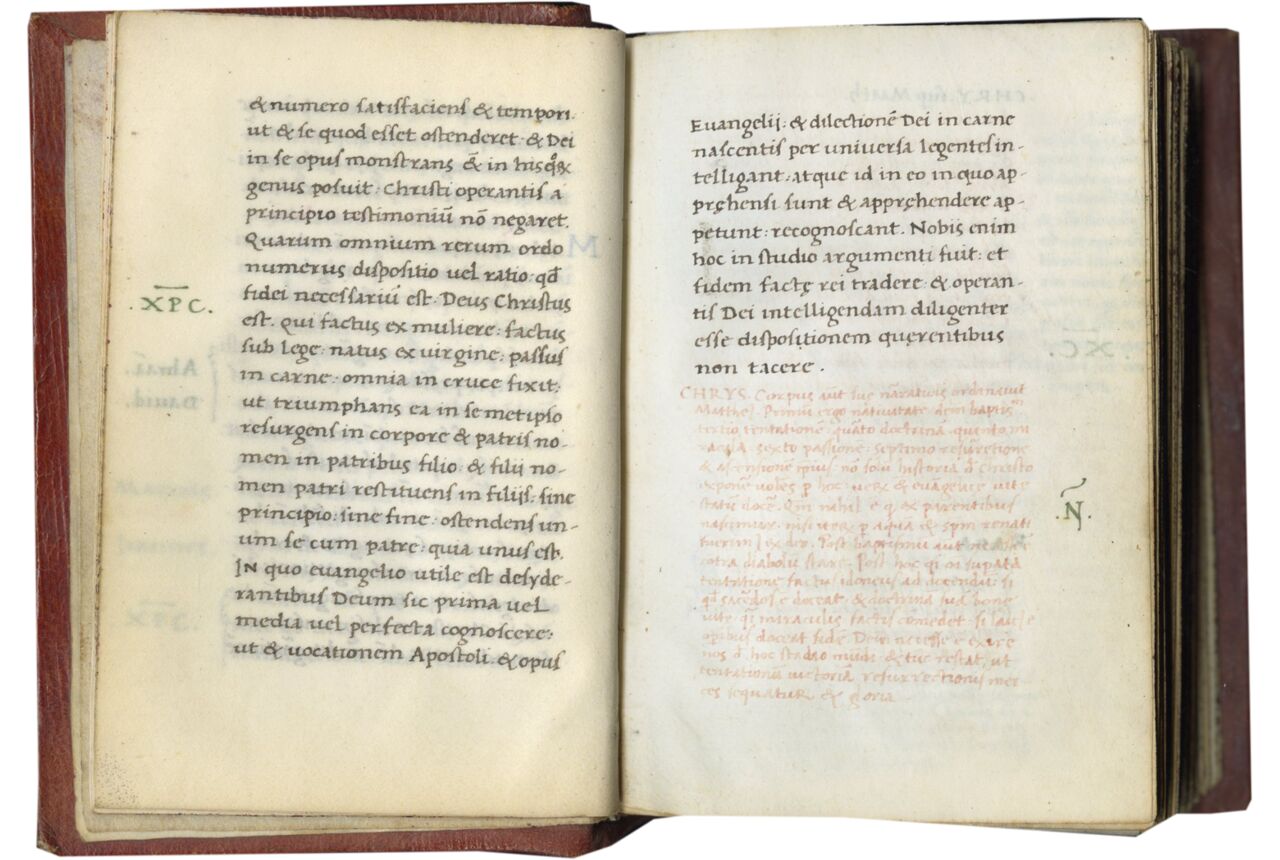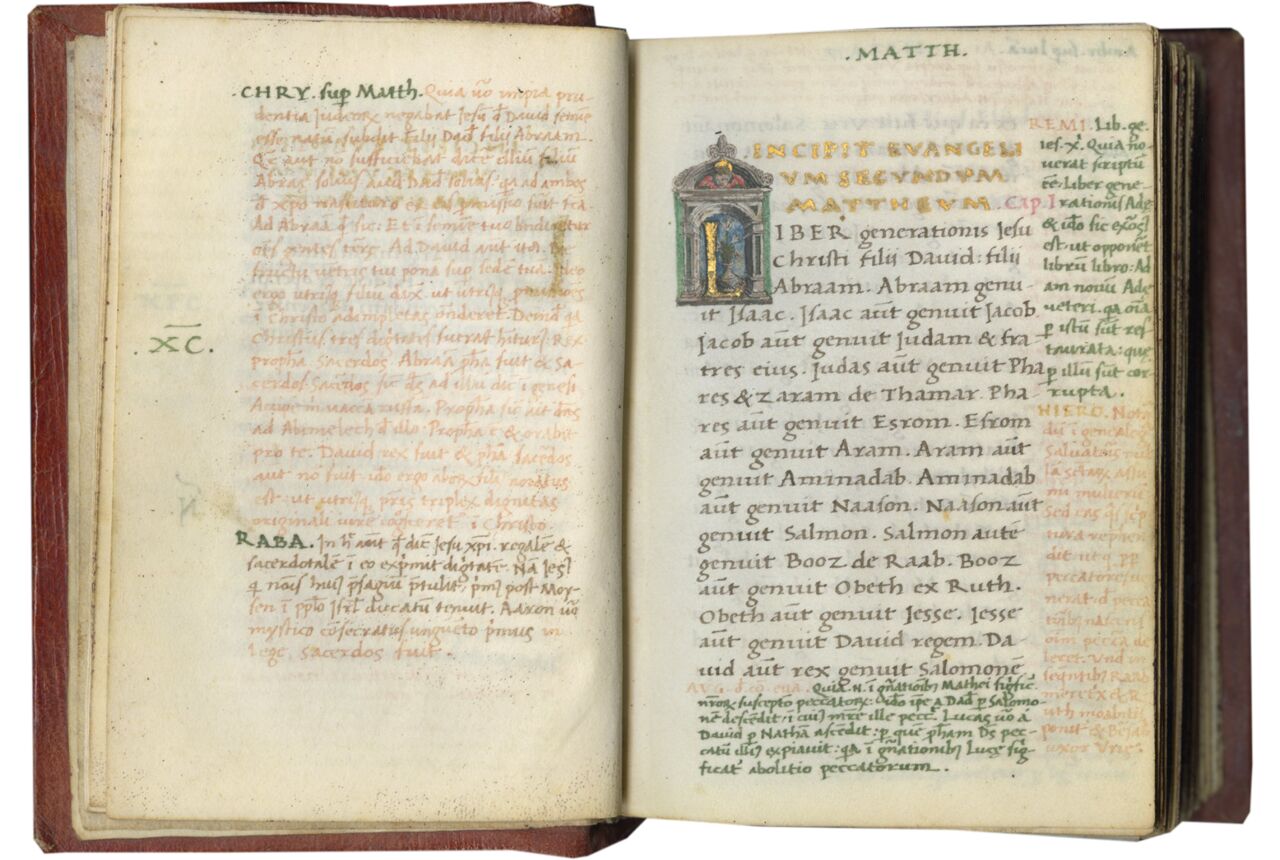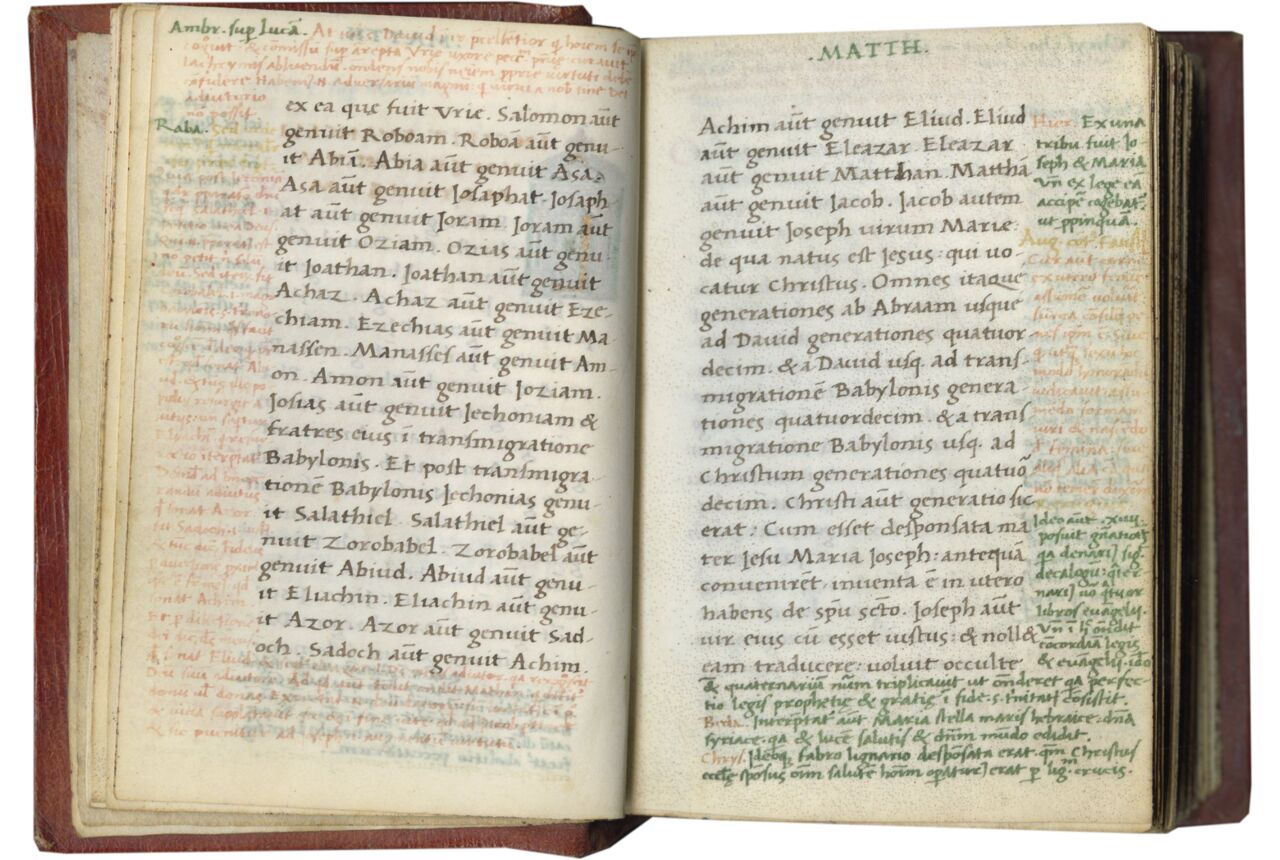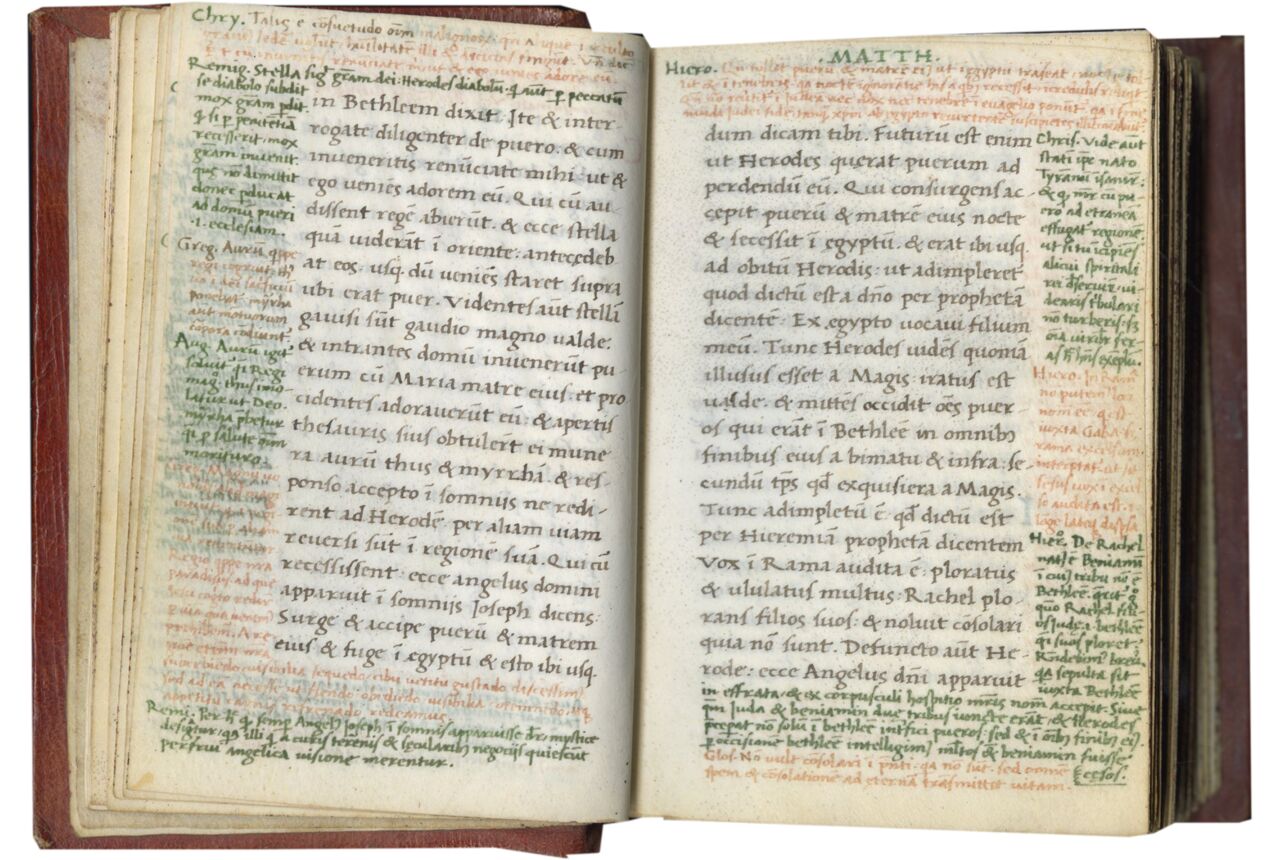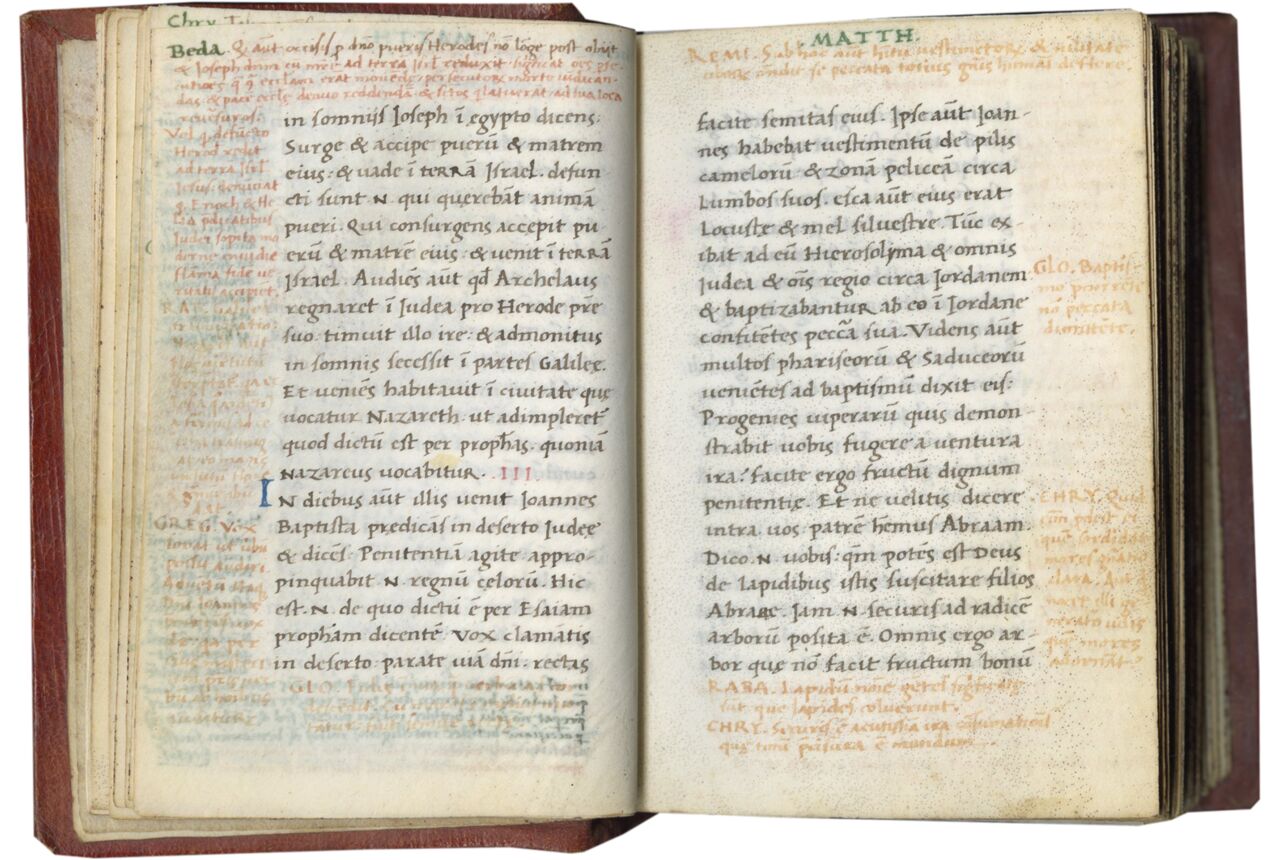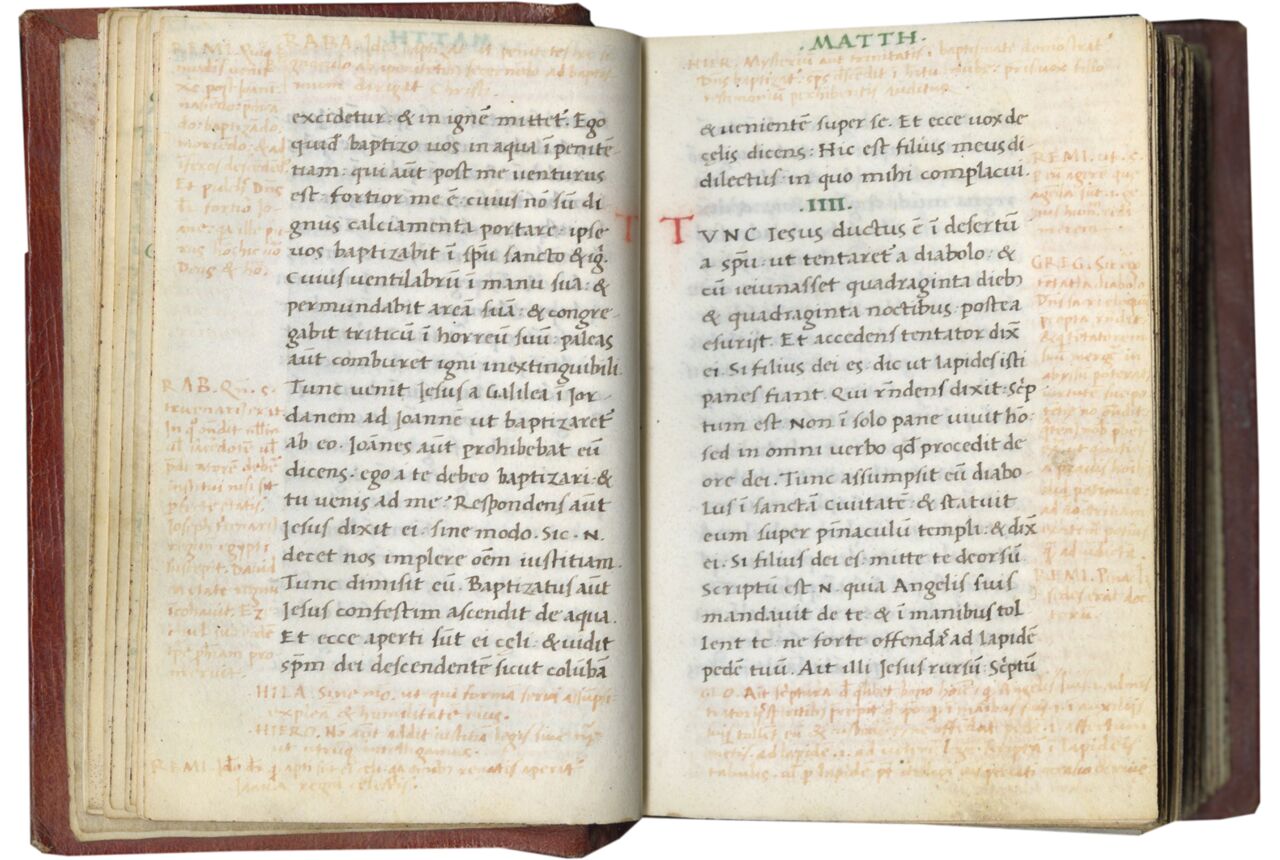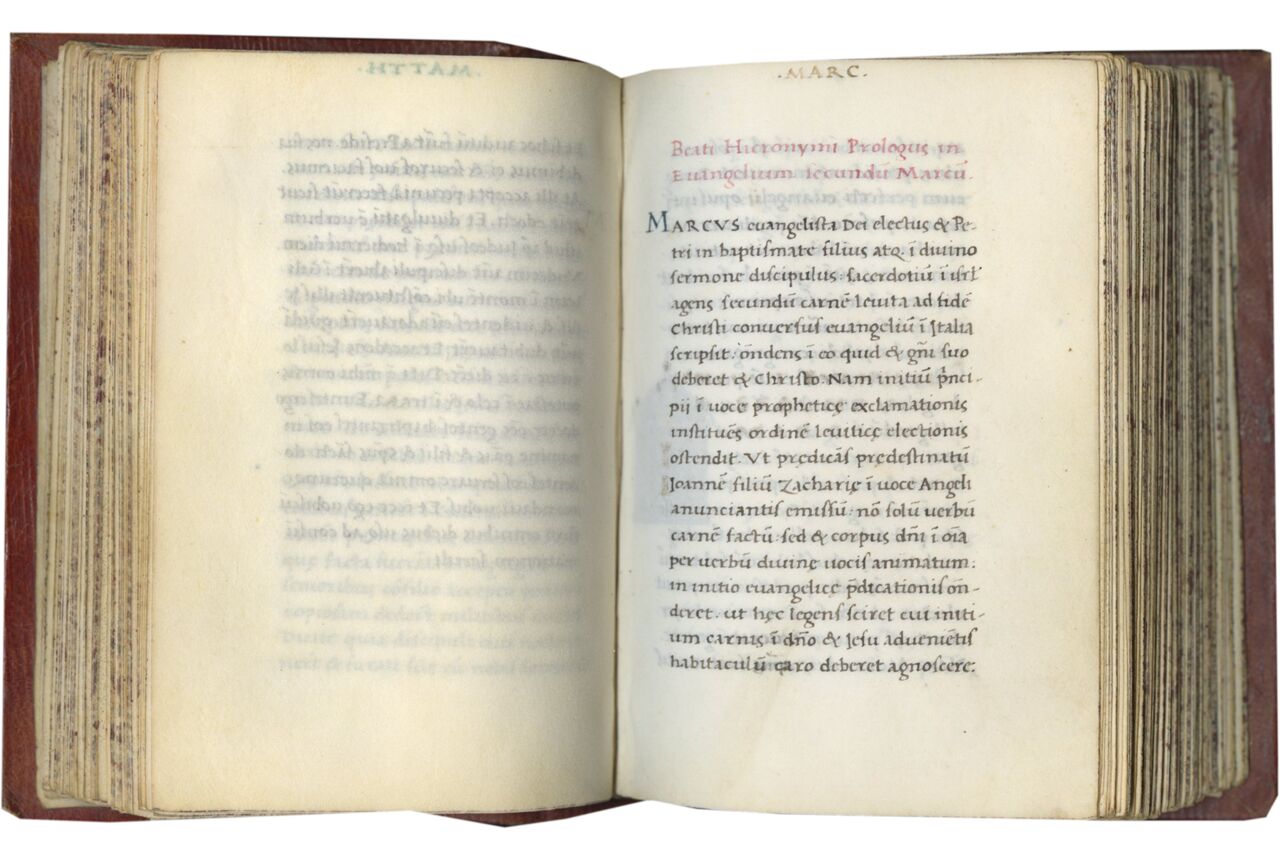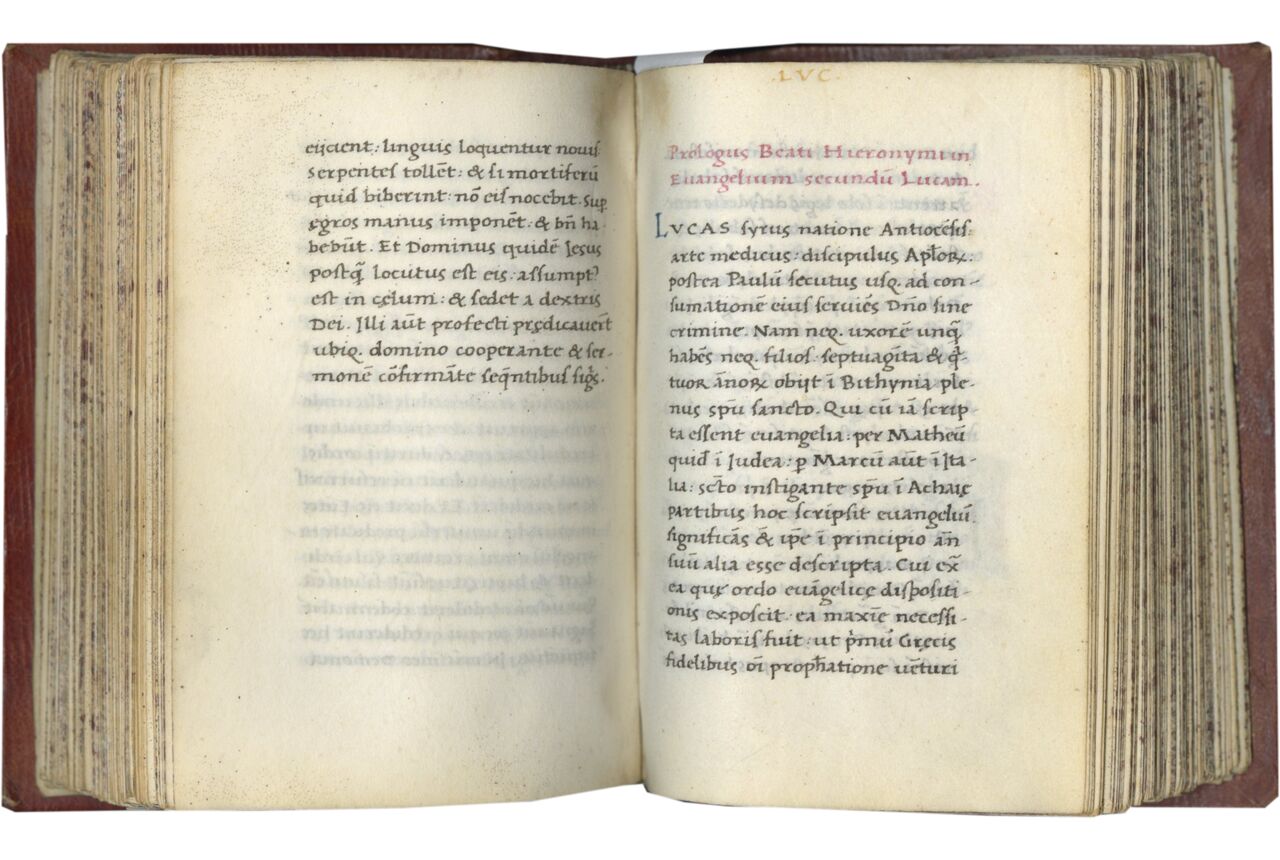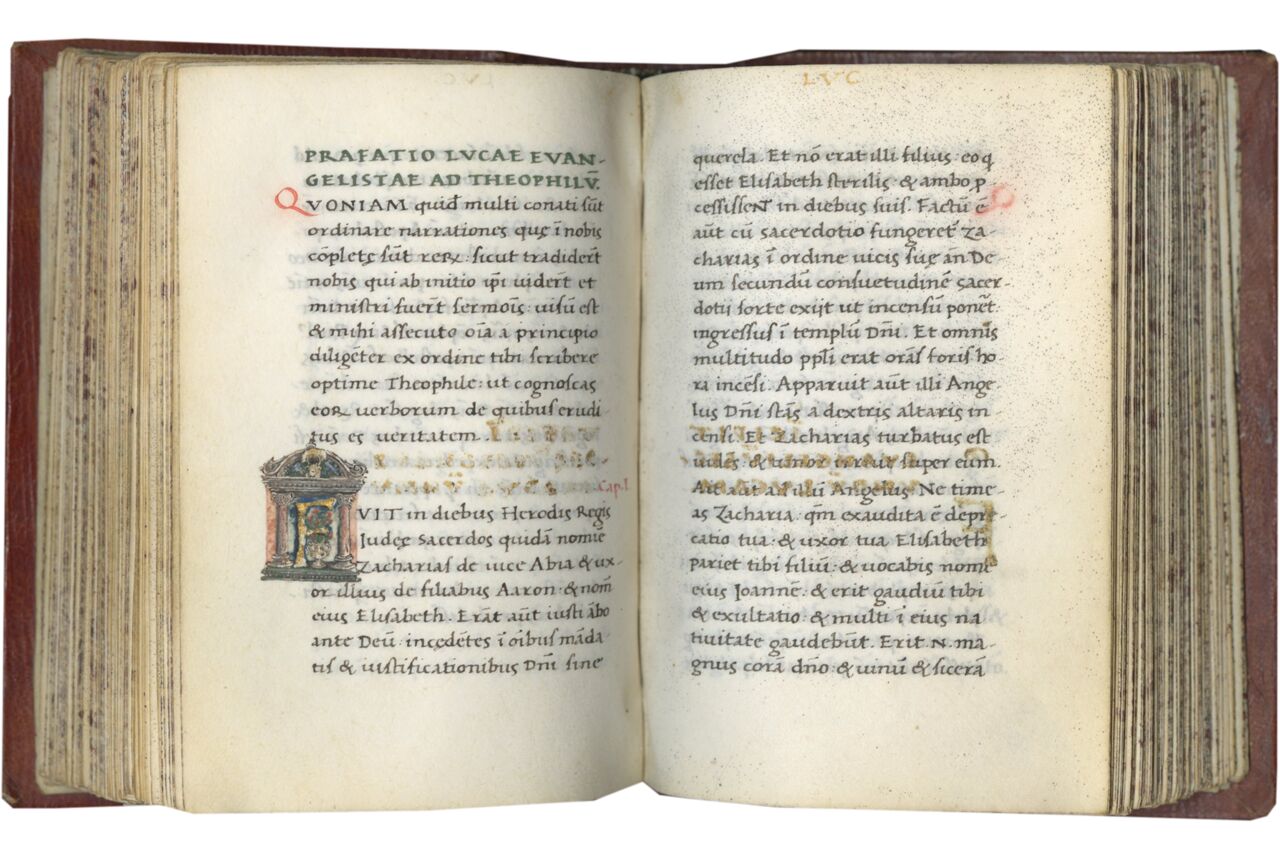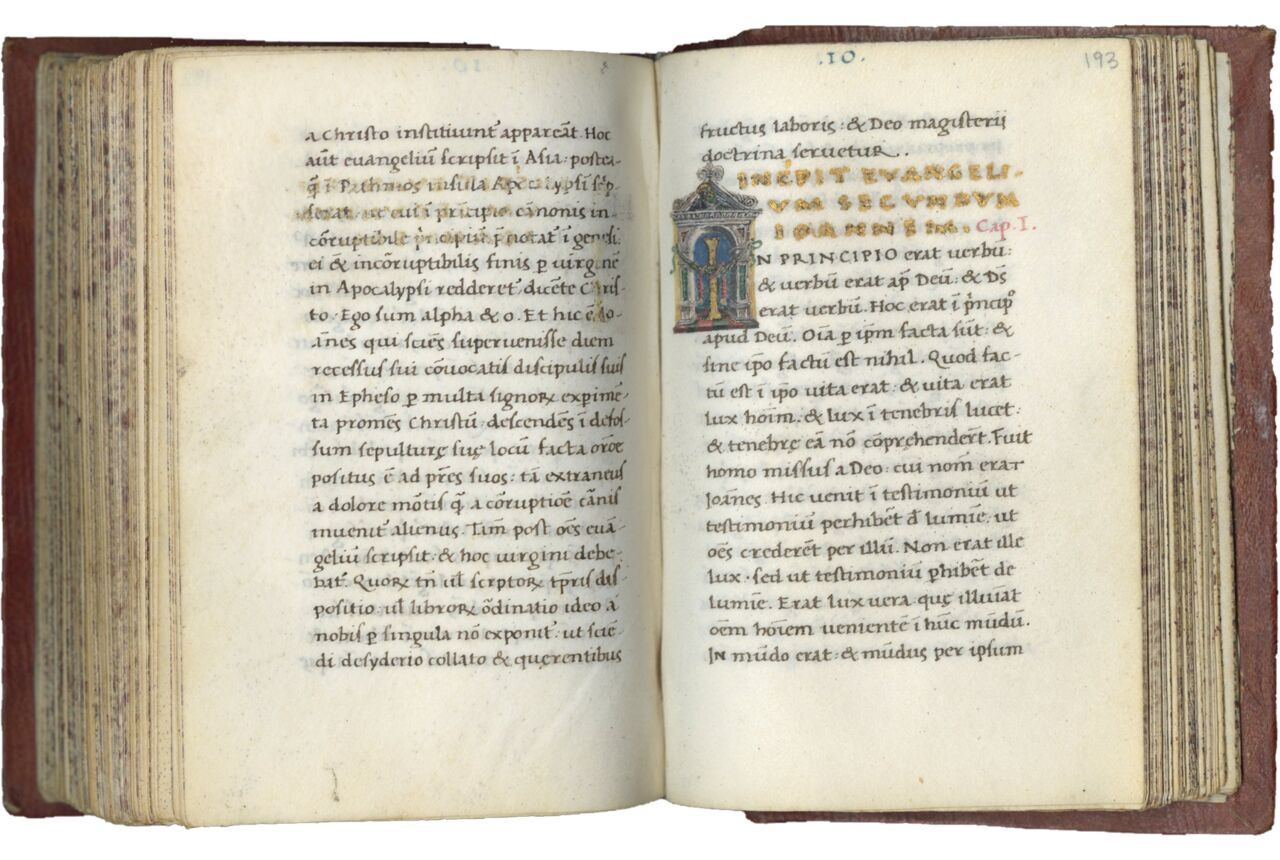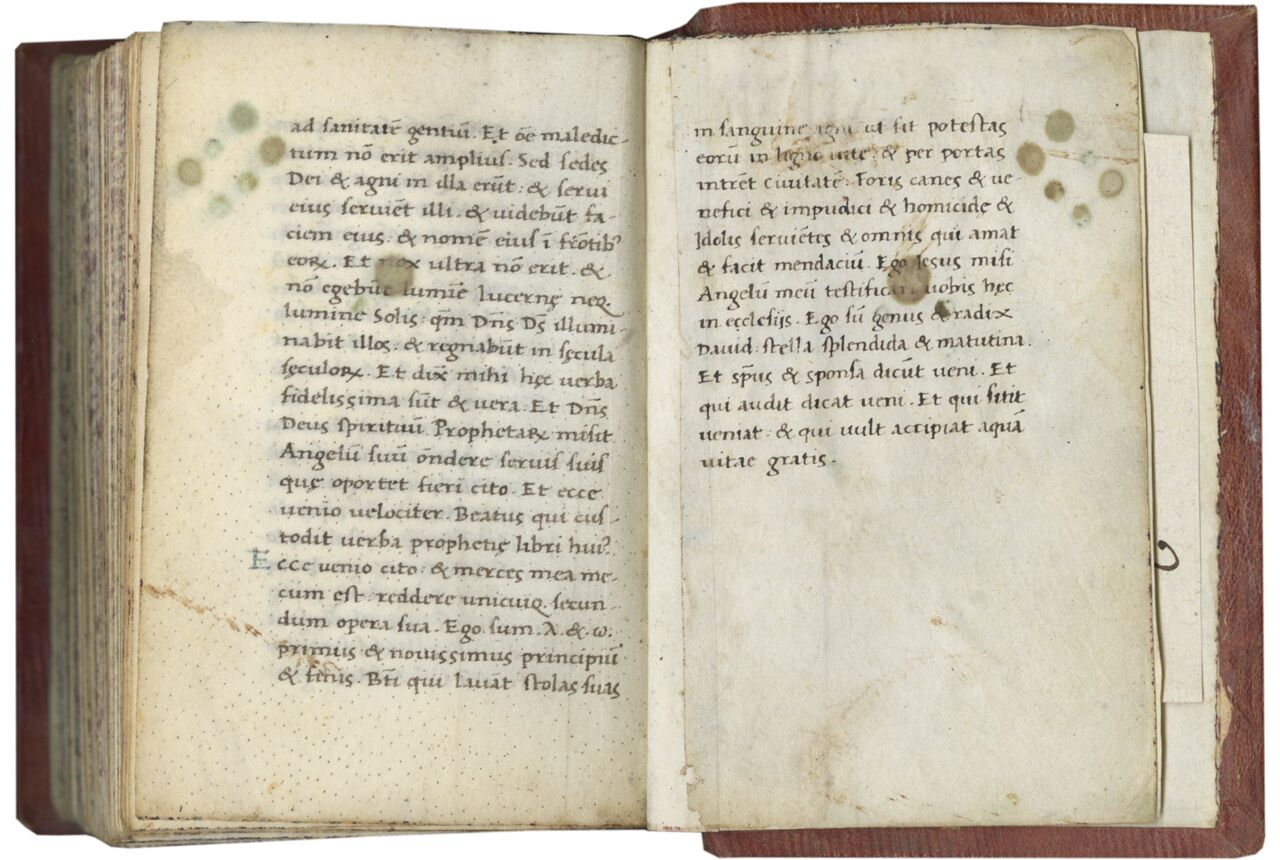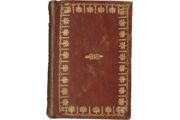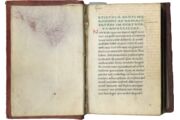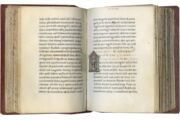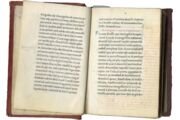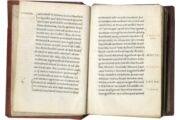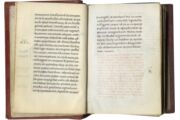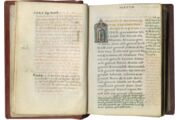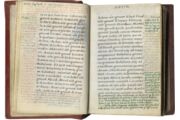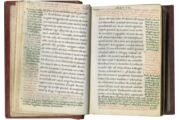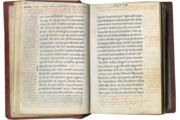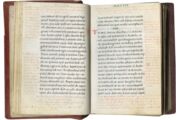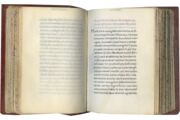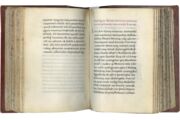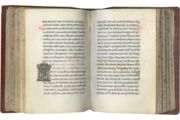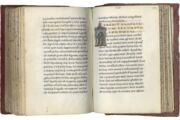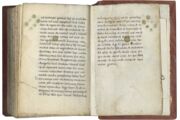i + 258 + i folios on very thin parchment of exceptionally fine quality, modern foliation in pencil, 1-258, complete (collation i10 ii-xxi12 xxii8), no ruling visible (justification 80 x 46 mm.), written in gray ink in a very fine humanistic script in single column on 21 lines, rubrics (including chapter numbers in capitals) in green or red inks, running titles in the upper margin on the recto in capitals in green ink (Matthew and John) or red ink (Mark and Luke), rubrics to main texts (titles) in capitals in green ink or in liquid gold (Gospels), the contemporary gloss in a less formal humanistic script in brownish red (now very pale) and green inks, initials alternate in blue and red (c. 2 lines in height), four very fine 6-line illuminated initials: the letter in liquid gold is placed inside an antique arch, and on f. 10, a large vase of lilies, on f. 121v, a vase of roses, the tympanum of the arch decorated with the symbol of the evangelist: an angel with red wings, lion, ox, eagle (ff. 10, 78, 121v, 193), loss of liquid gold on the rubrics on ff. 78 and 121v (off-set on the facing page), minor water damage in the inner margins of some leaves, minor signs of use, in overall excellent condition. Bound in Paris c. 1800-1828 in red morocco, both covers gold tooled with a fine border with palmettes and a centerpiece with a curling stem and bud pattern, a flat spine entirely filled with gold tooled decoration combining geometric and floral motifs, marbled edges, green cardboard slipcase lined with marbled paper, minor signs of wear on the leather, in overall excellent condition. Dimensions 113 x 77 mm.
This tiny manuscript (measuring only 4.4 x 3 inches) is as lovely as it is unusual. The four Gospels, copied throughout the Middle Ages in manuscripts made for liturgical use, are transformed in this manuscript into a humanist book for personal use and study. Its beautiful script, sometimes in goldleaf, and lovely illuminated initials are noteworthy. Intriguingly, this manuscript has traditionally been associated with one of the most influential men of the Renaissance Italy, Girolamo Savonarola, and its marginal commentary comes from Thomas Aquinas, whose writings Savonarola studied in detail.
Provenance
1. The beautiful humanistic script of this manuscript denotes that it was made in Italy, perhaps in Florence, in the last quarter of the fifteenth century.
2. An inscription on the front flyleaf, “In usum...Savonarol ...”, is evidence of an association of our manuscript with Girolamo Savonarola (1452-1498), the famous Florentine preacher that dates to the late fifteenth- or sixteenth century. Another inscription, copied above it, is now illegible. A later eighteenth-century inscription in Italian, written on a piece of paper and pasted on the back pastedown, erroneously attributes the marginal gloss (ff. 1-26v) to Savonarola: “le postille marginali in varii colori si credono del Savonarola. Vi sono ancora alcune miniature per iniziali”. This note is followed by what appears to be a shelfmark: “T15”.
3. On the front pastedown, engraved ex-libris of I. R. Delmas with the Greek word ΕΞΟΧΟΤΕΡΩΣ (Exactly) amid books under a sundial.
4. Sold by Renaud-Giquello in Paris on 8 February 2006, lot 132.
Text
ff. 1-258, Main text:
ff. 1-4, Epistola Beati Hieronymi ad Damasum papam in quatuor evangelistas, incipit, “Novum opus me facere coqis ex veteri: ut post exemplaria scripturarum toto orbe dispersa ... et memineris mei Papa beatissime.”;
Prologue to the Gospels, Jerome, Epistle Pope Damasus I, with gloss (see below); Stegmüller, vol. 1, 1950, no. 595; for an English translation, see Online resources.
ff. 4-7, Prologus in iiij. Evangelistas, incipit, “Plures fuisse qui evangelia scripserunt ... ecclesiasticis vivis caritas.”;
Prologue to the four Gospels, attributed to St. Jerome, with gloss (see below); Stegmüller, vol. 1, 1950, no. 596; De Bruyne, 1914, p. 155-156 (explicit, “… vivis canendas”).
ff. 7-8, Prologus in Mattheum, incipit, “Matheus cum primo predicasset evangelium in Judea ... divinitatis sacramentum.”,
Prologue, with gloss (see below), Stegmüller, vol. 1, 1950, no. 589 (from the Glossa ordinaria and found in the Paris Bible).
ff. 8-9, Argumentum in Mattheum, incipit, “Matheus ex Judea sicut ... et operantis Dei intelligendam diligenter esse dispositionem querentibus non tacere.”,
Prologue to Matthew with gloss (see below), Stegmüller, vol. 1, 1950, no. 591.
ff. 10-76, Incipit evangelium secundum Mattheum. Cap. I, incipit, “Liber generationis Jesu Christi filii David, filii Abraam, Abraam genuit Isaac ... ad consummationem seculi.”; [f. 76v, blank];
Gospel of Matthew, with gloss beginning on f. 9v, and then continuing in the margins, ff. 10-26v (see below).
ff. 77-78, Beati Hieronymi Prologue in Evangelium secundum Marcum, incipit, “Marcus evangelista Dei electus et Petri in baptismate filius ... incrementum prestat Deus est.”,
Prologue to the Gospel of Mark; Stegmüller, vol. 1, 1950, no. 607.
ff. 78-119v, Incipit evangelium secundum Marcum. Cap. I [loss of the liquid gold, offset on the facing page], incipit, “Initium evangelii Jesu Christi filii Dei sicit scriptum est in Isaia propheta: Ecce mitto Angelum meum ... sermonem confirmante, sequentibus signis.”;
Gospel of Mark.
ff. 120-121, Beati Hieronymi Prologue in Evangelium secundum Lucam, incipit, “Lucas syrus natione Antiochensis arte medicus discipulus Apostolorum ... fasti dientibus prodidisse.”,
Prologue to the Gospel of Luke; Stegmüller, vol. 1, 1950, no. 620.
f. 121v, Prefatio Lucae Evangeliste ad Theophilum, incipit, “Quoniam quidem multi conati sunt ordinare narrationem ... de quibus eruditus es, veritatem.”;
Luke 1:1-4, here treated as a prologue as is common in late medieval Bibles.
ff. 121v-191v, Incipit evangelium secundum Lucam. Cap. I [loss of the liquid gold, offset on the facing page], incipit, “Fuit in diebus Herodis, Regis Judee ... et erant semper in templo, laudantes et benedicentes Deum. Amen.”;
Gospel of Luke.
ff. 192-193, Beati Hieronymi Prologue in Evangelium secundum Joannem, incipit, “Hic est Joannes Evangelista unus ex discipulis Domini ... et Deo magisterii doctrina servetur.”;
Prologue to the Gospel of John; Stegmüller, vol. 1, 1950, no. 624.
ff. 193-245, Incipit evangelium secundum Ioannem. Cap. I, incipit, “In principio erat verbum ... posse eos qui scribendi sunt libros. Quattuor evangeliorum finis.”;
Gospel of John.
ff. 245-258, Paulus Apostolus ad Romanos. Cap. VIII [Romans 8:31], incipit, “Si Deus pro nobis quis contra nos ... [Apocalypse 22:12-17] Ecce venio cito … et qui sitit veniat, et qui vult accipiat aquam vitae gratis.”
Biblical excerpts from Romans, 1 Corinthians, Acts, James, Peter, and the Apocalypse.
Gloss:
ff. 1-26v, [marginal gloss, f. 1], incipit, “Aug(ustinus) Contra Faustum. Evangeli nomen latine. Interpretatur bonus nuntius ...; Chry[sostomus] Homelia, Quid enim bonus …; …. [f. 9v], Chry[sostomus] super Mattheum. Quia uero impia prudentia …; [f. 10]. REMI[gius] Liber generatio iesu christi. Quia noverat scriptum esse. Liber generationis, ... [f. 26v, final gloss from Rabanus Maurus is illegible].”
Our manuscript provides a commentary, or a gloss, to the four prologues to the Gospels and Matthew at the beginning of the manuscript and to the first nine chapters of Matthew (ff. 1-26v). Copied in a very small script in the margins around the biblical text (and in one case, f. 9v, occupying a complete page facing the beginning of Matthew), often using red ink, are selected passages from various sources, primarily patristic authors, with some later writers, and occasionally, the Glossa ordinaria. The study of selected passages suggests strongly that the source for the commentary in our manuscript was the Catena aurea in Matthaeum (The Golden Chain on Matthew) by St. Thomas Aquinas (ed. Guarienti, 1953; translation of Aquinas’s text in English, and a recent electronic edition of Aquinas’s text, see Online Resources). In our manuscript, the first gloss, written in the upper margin of f. 1, derives from the Contra Faustum Manichaeum of St. Augustine of Hippo (see Contra Faustum Manichaeum, book 2, paragraph 2, edited in CSEL 25, p. 255.12-18; Gloss-e in Online resources). The commentary also includes sections from St. Jerome, St. Augustine, Rabanus Maurus, the Venerable Bede, St. John Chrysostom, St. Gregory the Great, St. Hilary of Poitiers, Origen of Alexandria, and St. Ambrose. Some parts of the gloss are from the Glossa Ordinaria. All of the selected passages that we have studied are also found, word for word, in the Catena aurea.
Illustration
Four very fine and unusual 6-line illuminated initials: the letter in liquid gold is placed inside an antique arch, and with the tympanum of the arch decorated with the symbol of the evangelist:
f. 10, with a large vase of lilies; Matthew’s angel with red wings;
f. 78, Mark’s lion;
f. 121v, with a vase of roses, Luke’s ox;
f. 193, John’s eagle.
Gospel Books, manuscripts containing the text of the four Gospels, were among the most important type of biblical manuscripts in the Middle Ages, and many survive. Some of the most famous manuscripts from the early Middle Ages were Gospel Books: the Book of Kells, the Lindisfarne Gospels, the Golden Gospels of Henry III (to name just a few). Most Gospel Books were copied to be used in church, during the liturgy of the Mass, and they were fairly large (although not usually gigantic) in size. Our manuscript, which is very tiny, could not be more different. Here we have a very rare example of a Gospel Book copied for personal use; the marginal commentary suggests it was used for study. The lovely humanistic script in this manuscript and its beautiful and stylistically unusual initials also set this Gospel Book apart. Copying a biblical text in a humanistic script is quite rare; Gothic script continued to be used, even in fifteenth-century Italy, for liturgical manuscripts and Bibles.
St. Thomas Aquinas (1225-1274) is known today chiefly for his theological and philosophical commentaries, but he was also the author of important biblical commentaries. The Catena aurea was written at the request of Pope Urban IV at the end of 1263 or in early 1264. It is said that Thomas put together the commentary on Matthew, with the help of florilegia and a staff of secretaries before the death of the Pope in October 1264. It was extremely successful, circulating widely and for many centuries, and survives in more than 230 manuscripts (Fama, Online Resources; Stegmüller nos. 8044-8047). It is a very lengthy work, that constructs a commentary on each of the Gospels from direct quotations from the Church Fathers, as well as from some medieval authors, and occasionally the Glossa Ordinaria. These quotations are arranged in the order of the Bible and are carefully identified by author and title. Manuscripts of the complete work were usually copied as continuous commentaries in two columns, interrupted occasionally by short lemmata from the Bible copied in a larger script (the commentaries are far longer than the biblical lemmata). In our manuscript, which includes only a small number of the many quotations in the original work, the format is one of a marginal gloss, with the Gospel text occupying most of the page, and the commentary arranged around it in the margins. The text in our manuscript is likely a unique customized copy of St. Thomas’s text, made for the original owner of our manuscript, and as such is a fascinating example of the continued active use this text in Renaissance Italy.
Our manuscript appears to have been made during the lifetime of Girolamo Savonarola (1452-1498). Its association with this famous (and infamous) Dominican preacher, suggested by the note on the front flyleaf (see Provenance above) is certainly intriguing, and its very small size, so unusual for a Gospel Book, does suggest that it was a book that could have been used by an itinerant preacher like Savonarola. Savonarola was born in Ferrara in 1452. He studied classics and poetry at the University of Ferrara before entering the Dominican order in Bologna in 1475, and embarking on his theological studies that included the study of the Bible, and the works of Thomas Aquinas. He was appointed lector at the Convent of San Marco, in Florence, in 1481 or 1482. Though Savonarola’s initial preaching efforts in Florence met with little success, after traveling and preaching in northern Italy for several years he returned to Florence in 1489, and rapidly became an influential and popular voice (and personality) in the city, where he denounced corruption in the Church and prophesized its impending renewal. For a time, Florentines enthusiastically embraced Savonarola’s determination to rid the city of vice: Savonarola famously presided over a so-called bonfire of the vanities in 1497, in which his supporters publicly burned ‘vanities’ including cosmetics, fine clothes, playing cards, and secular books and works of art. However, Savonarola’s increasingly zealous attacks on the Church aroused the ire of Pope Alexander VI (sedit 1492-1503), and he was excommunicated in 1497. After a brief imprisonment, Savonarola was executed on 23 May 1498 as a heretic.
Literature
Conticello, C. G. “San Tommaso ed i Padri: la Catena aurea super Ioannem,” Archives d’Histoire Doctrinale et Littéraire du Moyen Age 57 (1990), 31-92.
De Bruyne, D. Prefaces to the Latin Bible, Namur, 1914 (reprint, Turnhout, 2015).
Guarienti, Angelico. S. Thomae Aquinatis. Catena aurea in quatuor Evangelia, Turin and Rome, 1953.
Martines, L. Fire in the City: Savonarola and the Struggle for Renaissance Florence, New York, 2006.
Morris, S. The Pope’s Greatest Adversary: Girolamo Savonarola, South Yorkshire, 2021.
Smith, L. The Glossa Ordinaria: The Making of a Medieval Bible Commentary, Leiden, 2009.
Stegmüller, F. and N. Reinhardt, Repertorium biblicum medii aevi, 11 vols, Madrid, 1950-1980.
Torrell, J.-P. Initiation à saint Thomas d'Aquin: sa personne et son œuvre, Vestigia 13, revised second edition, Fribourg and Paris, 2002,
Weinstein, D. and V. R. Hotchkiss, eds. Girolamo Savonarola: Piety, Prophecy and Politics in Renaissance Florence, Dallas, 1994.
Weinandy, Thomas Gerard. Aquinas on Scripture: An Introduction to His Biblical Commentaries, London, 2005.
Online Resources
CSEL 25, Augustine
https://archive.org/details/corpusscriptoru27wissgoog/page/n5/mode/2up?view=theater
FAMA, Thomas Aquinas, Catena aurea
http://fama.irht.cnrs.fr/en/oeuvre/268435
Gloss-e: Glossae Scripturae Sacrae-electronicae, IRHT, Paris
https://gloss-e.irht.cnrs.fr/
Girolamo Savonarola
https://www.newadvent.org/cathen/13490a.htm
Jerome’s Letter to Pope Damasus on his translation of the Gospels
https://www.fourthcentury.com/jerome-gospel-revision-382/
Stegmüller, Repertorium Biblicum medii aevi, Online
https://www.repbib.uni-trier.de/cgi-bin/rebihome.tcl
Thomas Aquinas, Catena Aurea
https://www.ccel.org/ccel/aquinas/catena1.titlepage.html
Thomae de Aquino, Expositio continua sive Catena aurea in quatuor evangelia. Editio critica electronica in fieri, fontibus repertis, textuque emendato, ed. Martin Morard, coll. Fabio Gibiino, Adele Di Lorenzo, Véronique Somers, C. Giuseppe Conticello, Marie-Odile Boulnois, Anne-Catherine Baudoin et alii, in Glossae Sacrae Scripturae electronicae, 2022
https://Gloss-e.irht.cnrs.fr
TM 1323


